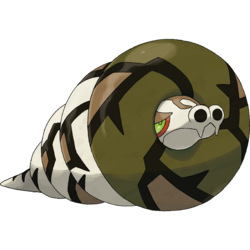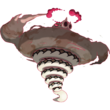From Bulbapedia, the community-driven Pokémon encyclopedia.
Sandaconda (Japanese: サダイジャ Sadaija) is a Ground-type Pokémon introduced in Generation VIII.
It evolves from Silicobra starting at level 36. It also has a Gigantamax form.
Biology

|
This section does not yet meet the quality standards of Bulbapedia. Please feel free to edit this section to make it conform to Bulbapedia norms and conventions.
|
Sandaconda is a tan serpent Pokémon with a black and brown pattern resembling cracked earth. Around its neck is a dark brown ring, its neck pouch, featuring the same pattern as the rest of its long body, which is coiled in a spiral shape. It has lime green eyes with red bags underneath them and a snout with two prominent nostrils and two fangs.
Sandaconda uses its inflated sand pouch to protect its head from harm. The pouch can store up to 220 pounds of sand for a time. The pouch is very elastic and thick to the point a Durant's pincers cannot harm it. Sandaconda can contract its body to spray the sand stored in the pouch through its nose with tremendous force, and its unique method of coiling allows it to blast its sand more efficiently. The sand is mixed with sharp pieces of gravel, making it so dangerous that just coming in contact with it will cause lacerations. While Sandaconda may act tough and confident, it will become timid and cowardly the moment it runs out of sand.[1] Sandaconda is a natural predator of Durant.
As Gigantamax Sandaconda, it becomes larger and standing on its taillike a cobra. The body has coil around with the head and neck in middle to resemble that of a tornado. The neck pouch enlarges and becomes same color as body with tons of sand surrounding it. Three red clouds float around the neck. The green sclera in eye changes to bright red.
When Gigantamaxed, the sand overflows from the pouch and forms a ring around Sandaconda's neck, with total amount of sand swirling around its body now reaching 1,000,000 tons. Gigantamax Sandaconda resembles an enormous tornado, and it attacks by spinning its body at high speeds, causing the sand to move at incredible speeds and inflicting massive damage to anything that touches it. It is powerful enough to pulverize a skyscraper in this way.[2]
Gigantamax Sandaconda is the only known Pokémon capable of using the exclusive G-Max Move G-Max Sandblast.
In the anime
Major appearances
Minor appearances
In the manga
In the TCG
- Main article: Sandaconda (TCG)
Game data
Pokédex entries
Sandaconda
| This Pokémon was unavailable prior to Generation VIII.
|
| Generation VIII
|
|
|
Galar
#313
|
| Sword
|
When it contracts its body, over 220 pounds of sand sprays from its nose. If it ever runs out of sand, it becomes disheartened.
|
| Shield
|
Its unique style of coiling allows it to blast sand out of its sand sac more efficiently.
|
|
|
Gigantamax Sandaconda
| This Pokémon was unavailable prior to Generation VIII.
|
| Generation VIII
|
|
|
Galar
#313
|
| Sword
|
Its sand pouch has grown to tremendous proportions. More than 1,000,000 tons of sand now swirl around its body.
|
| Shield
|
Sand swirls around its body with such speed and power that it could pulverize a skyscraper.
|
|
|
Game locations
| This Pokémon was unavailable prior to Generation VIII.
|
|
|
| This Pokémon was unavailable prior to Generation VIII.
|
|
|
Stats
Base stats
| Stat
|
Range
|
| At Lv. 50
|
At Lv. 100
|
72
|
|
132 - 179
|
254 - 348
|
107
|
|
100 - 174
|
197 - 344
|
125
|
|
117 - 194
|
229 - 383
|
65
|
|
63 - 128
|
121 - 251
|
70
|
|
67 - 134
|
130 - 262
|
71
|
|
68 - 135
|
132 - 265
|
Total: 510
|
Other Pokémon with this total
|
- Minimum stats are calculated with 0 EVs, IVs of 0, and (if applicable) a hindering nature.
- Maximum stats are calculated with 252 EVs, IVs of 31, and (if applicable) a helpful nature.
|
Type effectiveness
| Under normal battle conditions in Generation IX, this Pokémon is:
|
|
|
|
|
|
|
|
|
|
|
|
|
Learnset
|
|
|
|
- Bold indicates a move that gets STAB when used by Sandaconda
- Italic indicates a move that gets STAB only when used by an Evolution of Sandaconda
|
|
|
|
|
- Bold indicates a move that gets STAB when used by Sandaconda
- Italic indicates a move that gets STAB only when used by an Evolution of Sandaconda
|
|
|
|
|
- Moves marked with an asterisk (*) must be chain bred onto Sandaconda in Generation VIII
- Moves marked with a double dagger (‡) can only be bred from a Pokémon who learned the move in an earlier generation.
- Moves marked with a superscript game abbreviation can only be bred onto Sandaconda in that game.
- Bold indicates a move that gets STAB when used by Sandaconda
- Italic indicates a move that gets STAB only when used by an Evolution of Sandaconda
|
|
|
|
|
- Bold indicates a move that gets STAB when used by Sandaconda
- Italic indicates a move that gets STAB only when used by an Evolution of Sandaconda
|
|
|
|
|
- Bold indicates a move that gets STAB when used by Sandaconda
- Italic indicates a move that gets STAB only when used by an Evolution of Sandaconda
|
Evolution
Forms
Gigantamax
Trivia
Origin
Sandaconda appears to be based on an anaconda, though it may also be based on various desert-dwelling snakes, such as the sidewinder, a snake that uses coiling and rippling motions to travel across sandy dunes. It also may be based on a double-barreled gun.
Its Gigantamax form may be based on a dust devil.
Name origin
Sandaconda may be a combination of sand and anaconda.
Sadaija may be a combination of 沙 sa (sand) and 大蛇 daija (serpent).
In other languages
| Language
|
Title
|
Meaning
|
 Japanese Japanese
|
サダイジャ Sadaija
|
From 沙 sa and 大蛇 daija
|
 French French
|
Dunaconda
|
From dune and anaconda
|
 Spanish Spanish
|
Sandaconda
|
Same as English name
|
 German German
|
Sanaconda
|
From Sand and Anakonda
|
 Italian Italian
|
Sandaconda
|
Same as English name
|
 Korean Korean
|
사다이사 Sadaisa
|
From 사 (沙) sa, die, and 사 (蛇) sa
|
 Mandarin Chinese Mandarin Chinese
|
沙螺蟒 Shāluómǎng
|
From 沙 shā, 螺 luó, and 蟒 mǎng
|
 Cantonese Chinese Cantonese Chinese
|
沙螺蟒 Sālòhmóhng
|
From 沙 sā, 螺 lòh, and 蟒 móhng
|
|
|
|
| More languages
|
 Russian Russian
|
Сандаконда Sandakonda
|
From English name
|
|
|
|
Related articles
Notes
External links

|
This Pokémon article is part of Project Pokédex, a Bulbapedia project that aims to write comprehensive articles on each Pokémon species, as well as Pokémon groups and forms.
|















































